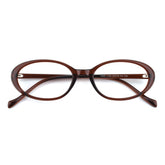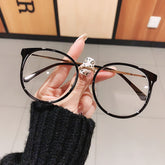What are progressive lenses?
Compared to single vision lenses which are only used to correct vision for distance or near separately, the progressive lenses can work more, including distance, near, and middle. If you find the both "Add" values are not blank, and your prescription type is marked as progressive, then you can choose progressive to serve you better with both distance and near vision.
This blog will explain:
- What Are Progressive Lenses?
- How Do Progressive Lenses Work?
- Who Can Choose Progressive Lenses?
- What Should You Pay Attention to When Choose Progressive Lenses?
- How to Choose Right Frames for Progressive Lenses?
1 What Are Progressive Lenses?
Progressive lenses, often referred to as "no-line bifocals," are multifocal lenses that provide a smooth transition between different vision zones. Unlike traditional bifocals or trifocals, which have visible lines separating different areas of vision correction, progressive lenses offer a seamless blend between the various lens powers needed for distance, intermediate (such as computer work), and near vision (such as reading).

2 How Do Progressive Lenses Work?
Progressive lenses are designed with a gradual change in lens power from the top of the lens to the bottom:
- Top of the Lens: Corrects for distance vision, helping you see things clearly that are far away.
- Middle of the Lens: Provides intermediate vision, perfect for tasks like computer work or looking at your dashboard while driving.
- Bottom of the Lens: Offers near vision correction, ideal for reading or any close-up work.
This gradual shift allows for a natural transition between seeing objects at various distances, making the visual experience more comfortable and less jarring than with traditional bifocals or trifocals.
3 Who Can Choose Progressive Lenses?
-
People with Presbyopia: As we age, the eye's natural lens loses flexibility, making it difficult to focus on close objects. Progressive lenses are ideal for those experiencing presbyopia, typically starting around age 40.
-
Those Who Want a Seamless Look: If you prefer glasses without visible lines or segments, progressive lenses provide a sleek, modern appearance while offering all the benefits of multifocal lenses.
-
Individuals Who Need Multiple Vision Corrections: Progressive lenses are perfect for those who need correction for both near and distance vision but don’t want to switch between multiple pairs of glasses.
4 What Should You Pay Attention to When Choose Progressive Lenses?
As progressive lenses contain 3 different parts to help you see near, far and middle separately, it will require an adaptation time to get used to them.
Some new wearers may experience distortion and dizziness for the first time. To overcome this, it’s important to wear the new glasses consistently during this period to speed up the adaptation process. With regular use, most people adapt within a few days to a few weeks.
5 How to Choose Right Frames for Progressive Lenses?
Choosing right frames for progressive lenses requires careful consideration to ensure both comfort and optimal vision. Here are 2 tips to help you select the right frames:
-
Vertical Height: Progressive lenses require a certain vertical height to accommodate the different vision zones (distance, intermediate, and near). Choose frames with a lens height of at least 28-30 mm.
-
Avoid Small Frames: Smaller frames might not provide enough space for the progressive lens design, leading to a reduced field of view.
Progressive lenses are an excellent choice for anyone who needs multifocal vision correction but prefers a seamless, aesthetically pleasing design. While they may require some adjustment, the benefits of having clear vision at all distances in a single pair of glasses make them a popular and effective option.











